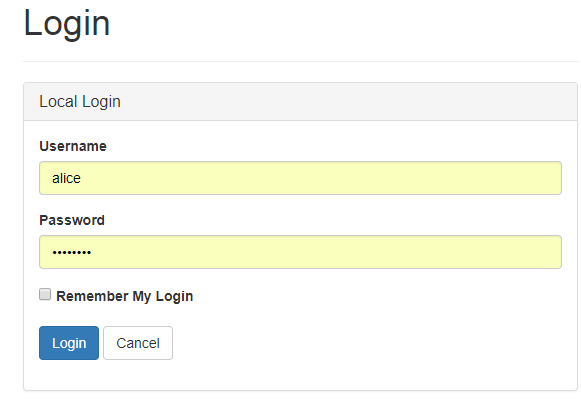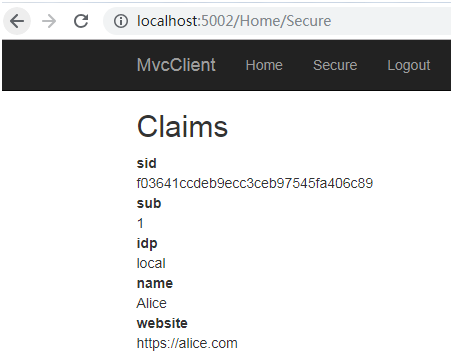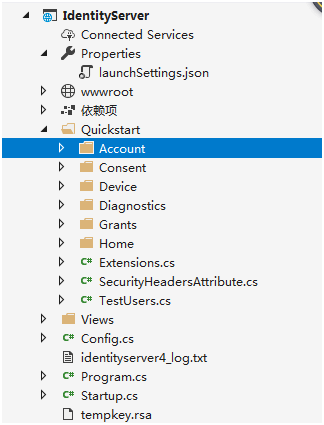一.概述 在前二篇中講到了客戶端授權的二種方式: GrantTypes.ClientCredentials憑據授權和GrantTypes.ResourceOwnerPassword密碼授權,都是OAuth2.0協議。本篇使用OpenID Connect添加用戶認證,客戶端授權是GrantTypes. ...
一.概述
在前二篇中講到了客戶端授權的二種方式: GrantTypes.ClientCredentials憑據授權和GrantTypes.ResourceOwnerPassword密碼授權,都是OAuth2.0協議。本篇使用OpenID Connect添加用戶認證,客戶端授權是GrantTypes.Implicit隱式流授權,是OCID協議。 本篇示例中只有二個項目:一個IdentityServer的mvc應用程式,一個客戶端mvc應用程式(用戶client端)。
下麵介紹身份認證交互流程:
(1) 先啟動IdentityServer程式http://localhost:5000
(2) 啟動客戶端MvcClient程式http://localhost:5002
(3) Client用戶訪問http://localhost:5002/Secure時,想獲取個人信息和資料信息,如果用戶沒有進行身份認證,OIDC會重定向
(4) 重定向到IdentityServer服務端站點的登錄頁:http://localhost:5000/Account/Login?ReturnUrl=xxx

(5) 用戶登錄成功後。自動跳回到MvcClient客戶端站點,訪問地址http://localhost:5002/Home/Secure。獲取了當前個人信息和資料信息

上面的步驟瞭解到:Client用戶要訪問個人信息時,必須先進行,互動式用戶身份驗證Account/Login,驗證通過後,客戶端瀏覽器會保存服務令牌在cookie中。 需要註意的是:在隱式授權中,令牌是通過瀏覽器傳輸,在MvcClient客戶端程式中用HttpClient獲取cookie中的令牌來請求api,返回是http 401狀態,這是因為該令牌是身份令牌還非訪問令牌。
從Github中下載開源項目,可以快速入門啟動OpenID Connect協議的互動式用戶身份驗證支持。在實際項目中,也可以將示例中的控制器,視圖,模型和CSS整合到自己項目的IdentityServer Web應用程式中。
二. IdentityServer MVC應用程式
因為是互動式用戶身份驗證,必須有UI界面,所以IdentityServer是一個MVC應用程式。下麵是示例項目目錄:

Account:客戶端站點重定向到服務端站點,用於用戶登錄或註銷。
Grants: 用於撤銷客戶端訪問許可權。
Consent :是用戶登錄成功後,跳轉到授權許可的UI界面。用戶可以決定是否要將他的身份信息發佈到客戶端應用程式。
Device :是設備流交互服務。
Diagnostics: 是診斷查看個人身份認證cookie信息。
1.1 定義客戶端
在config.cs類中,定義客戶端,將 OpenID Connect隱式流添加到客戶端。基於OpenID Connect的客戶端與OAuth 2.0客戶端非常相似。但由於OIDC中的流程始終是互動式的,因此我們需要在配置中添加一些重定向URL。
public static IEnumerable<Client> GetClients() { return new List<Client> { new Client { ClientId = "client", // no interactive user, use the clientid/secret for authentication AllowedGrantTypes = GrantTypes.ClientCredentials, // secret for authentication ClientSecrets = { new Secret("secret".Sha256()) }, // scopes that client has access to AllowedScopes = { "api1" } }, // resource owner password grant client new Client { ClientId = "ro.client", AllowedGrantTypes = GrantTypes.ResourceOwnerPassword, ClientSecrets = { new Secret("secret".Sha256()) }, AllowedScopes = { "api1" } }, // OpenID Connect implicit flow client (MVC) new Client { ClientId = "mvc", ClientName = "MVC Client", AllowedGrantTypes = GrantTypes.Implicit, //OIDC中的流程始終是互動式的 //登錄後要重定向到哪裡 RedirectUris = { "http://localhost:5002/signin-oidc" }, // 註銷後重定向到哪裡 PostLogoutRedirectUris = { "http://localhost:5002/signout-callback-oidc" }, //與OAuth 2.0類似,OpenID Connect也使用範圍概念,與OAuth相比,OIDC中的範圍不代表API,而是代表用戶ID,名稱或電子郵件地址等身份數據。 AllowedScopes = new List<string> { //主題id,也是用戶唯一ID(最低要求) IdentityServerConstants.StandardScopes.OpenId, //個人信息的claims,名稱或電子郵件地址等身份數據 IdentityServerConstants.StandardScopes.Profile } } }; }
1.2 定義OIDC範圍
public static IEnumerable<IdentityResource> GetIdentityResources() { return new List<IdentityResource> { new IdentityResources.OpenId(), new IdentityResources.Profile(), }; }
1.3 在Startup啟動類中啟動 IdentityServer服務
var builder = services.AddIdentityServer() .AddInMemoryIdentityResources(Config.GetIdentityResources()) .AddInMemoryApiResources(Config.GetApis()) .AddInMemoryClients(Config.GetClients()) .AddTestUsers(Config.GetUsers());
二. MvcClient 客戶端應用程式
2.1 Startup啟動類
添加對OpenID Connect身份驗證的支持,在啟動時將以下代碼添加到ConfigureServices方法中:
public void ConfigureServices(IServiceCollection services) { services.AddMvc(); //關閉了JWT聲明類型映射 JwtSecurityTokenHandler.DefaultInboundClaimTypeMap.Clear(); //添加authentication 到服務集合中 services.AddAuthentication(options => { //使用cookie本地登錄用戶 options.DefaultScheme = "Cookies"; //用戶登錄時,使用OpenID連接協議。 options.DefaultChallengeScheme = "oidc"; }) //添加對cookie的處理支持 .AddCookie("Cookies") //oidc處理程式 .AddOpenIdConnect("oidc", options => { //受信任的IdentityServer服務地址 options.Authority = "http://localhost:5000"; options.RequireHttpsMetadata = false; //客戶端標識 options.ClientId = "mvc"; //將IdentityServer中的令牌持久化到cookie中(客戶端瀏覽器中) options.SaveTokens = true; }); }
public void Configure(IApplicationBuilder app, IHostingEnvironment env) { if (env.IsDevelopment()) { app.UseDeveloperExceptionPage(); } else { app.UseExceptionHandler("/Home/Error"); } //每個請求都能執行身份驗證服務 app.UseAuthentication(); app.UseStaticFiles(); app.UseMvcWithDefaultRoute(); }
2.2 訪問個人信息
由於使用的是OpenID Connect,是基於瀏覽器的互動式身份認證。在action中添加一個[Authorize],會觸發身份驗證握手。下麵Secure方法,顯示當前用戶的聲明以及cookie屬性。 握手時重定向到IdentityServer服務站點下進行登錄。
//身份驗證握手,採用oidc,重定向到IdentityServer進行登錄 [Authorize] public IActionResult Secure() { ViewData["Message"] = "Secure page."; return View(); }
下麵是Secure視圖:
@using Microsoft.AspNetCore.Authentication <h2>Claims</h2> <dl> <!-- 顯示用戶聲明--> @foreach (var claim in User.Claims) { <dt>@claim.Type</dt> <dd>@claim.Value</dd> } </dl> <h2>Properties</h2> <dl> <!-- 顯示身份認中的cookie --> @foreach (var prop in (await Context.AuthenticateAsync()).Properties.Items) { <dt>@prop.Key</dt> <dd>@prop.Value</dd> } </dl>
2.3 註銷
使用IdentityServer等身份驗證服務,僅清除本地應用程式cookie是不夠的(客戶端瀏覽器)。此外,還需要向IdentityServer進行往返以清除中央單點登錄會話。
public IActionResult Logout() { return SignOut("Cookies", "oidc"); }
觸發Logout後,會清除本地cookie(客戶端瀏覽器),然後重定向到IdentityServer。IdentityServer將清除其cookie(服務端瀏覽器),然後為用戶提供返回MVC應用程式的鏈接。
參考文獻



